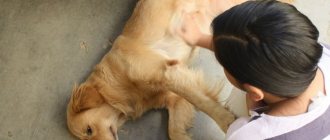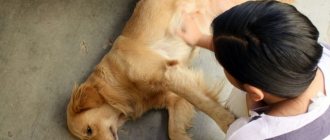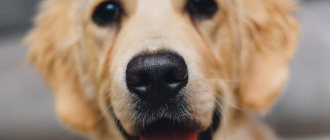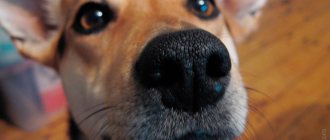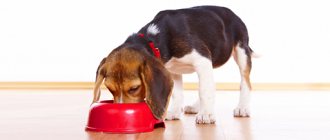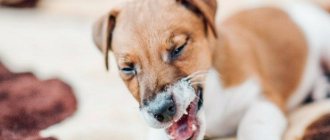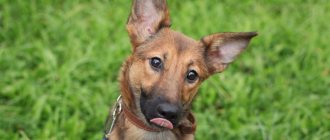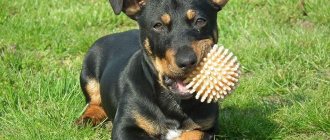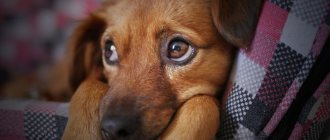A dog's nose is an amazing organ that allows the animal to subtly sense and distinguish smells. After all, smell is his main way of exploring the world and communicating. The structure of the respiratory organ is designed so that the dog can receive maximum information and, therefore, feel confident. It is not surprising that the condition of this organ is at the same time an indicator of its well-being. From this article you will learn why a dog’s nose can be dry and warm, what this condition indicates, and what the owner should do.
Why should your nose be wet and cool?
On the mucous membrane of a dog's nose, which lines its internal cavity and external lobe, there are so-called nasal glands that produce a special secretion. Thanks to this, the olfactory organ is always moist and cool. This is necessary, because this is how thermoregulation occurs. The fact is that the dog's body has a very small number of sweat glands. They are found on the paw pads and in the ear canals. Additional cooling occurs due to the respiratory organ.
In addition, a constantly moist surface of the nose ensures its maximum sensitivity. The dog is able not only to perceive the subtlest odors, but also to sense air movement. At the same time, she understands where their source is and divides the entire spectrum of aromas into their constituent components.
A healthy, active pet should have a moist, cool nose, which allows it to remove excess heat and distinguish odors in the best possible way. When a dog has a dry and warm nose, this makes the owner think that he is sick. Indeed, in some cases this is true, but not always.
Prevention
As preventive measures to protect your pet from possible dangers, it is recommended:
- Avoid plastic bowls and keep them clean. Give preference to ceramics or aluminum. They do not cause allergic reactions and prevent the increased growth of bacteria. Wash the feeders after each meal without adding detergent.
- Choose high-quality food and monitor the reaction of the dog’s body. When feeding natural foods, introduce new food gradually, studying the puppies' well-being.
- Use sunscreen not only for yourself, but also for your four-legged friend. In hot weather, lubricate your nose with it, and in winter, moisturize the mucous membrane with vegetable oils.
- Do not walk your dog near allergenic plants during the flowering period.
- Attend veterinary examinations, deworming and vaccinations in a timely manner.
Video
In what cases does the nose get warm?
A dry nose does not always indicate that the dog is sick. There are various situations and physiological conditions when the nose of a healthy pet is dry and hot. During this period, no more painful symptoms are observed. The dog is active, eats well, and enjoys going for walks.
A warm nose is normal for a dog in the following cases:
- The dog is sleeping or has just woken up. This happens because in this state she is completely calm and her muscles are relaxed. Once the dog wakes up and becomes active again, the function of the nose will return and it will again become wet, cold and sensitive.
- Stress and nervous tension are the main reasons for the release of the fear hormone cortisol into the blood, which causes reflex muscle contraction. At this time, the glands also cannot work as before, so temporary drying of the mucous membranes, including the nose, occurs.
- Physical fatigue also acts in a similar way.
- Features of physiology. The cause of a warm nose can be a slow metabolism when the mucous membrane behaves “passively”. Insufficient secretion of the nasal mucosa can be observed in such dogs throughout their lives.
- A puppy may have a dry nose simply due to his age. His nasal glands are not as active. Over time, everything will fall into place.
- Pregnant and lactating females may also have a warm, dry nose.
- In the hot season, when dehydration occurs, the mucous membranes dry out and crack. The dog should always have clean water freely available.
- The air in the apartment during the heating season is also excessively dry, which is why the surface of the pet’s nose sometimes cracks. Don’t forget to give your dog plenty to drink and humidify the air in the apartment.
Let's sum it up
A dog's dry nose is not a reason to panic. Watch your tailed pet. If he is active, cheerful, has a good appetite, excellent skin and coat condition, normal body temperature, smooth and even nose skin, and he breathes normally, then there is no reason to worry.
If the nose peels, cracks, becomes covered with blisters and scabs, breathing is difficult, extraneous sounds appear (coughing, wheezing, sneezing), the animal’s body temperature is increased or decreased, the dog refuses to eat, hides in a corner, constantly itches, the fur is disheveled and begins to fall out , extraneous symptoms appear (such as diarrhea, vomiting, and so on), in which case you need to urgently run to the veterinarian.
I hope the facts listed will help you figure out whether in one case or another a dry and warm nose in a dog is a sign of a disease or a normal reaction of the body.
Take care of your pets! And let your beloved little tail always have a cold and wet nose!
When should you pay special attention to your dog's health?
Unfortunately, quite often a hot nose is observed in a pet during illness. This includes literally all conditions accompanied by fever and dehydration. But, you need to remember that in this case, dry nose is not the only painful symptom. Usually it is accompanied by other, no less striking signs, indicating the nature of the pathology and the severity of the course. The main ones are:
- lack of appetite and sometimes thirst;
- increased thirst;
- excessive lethargy, refusal to play;
- the desire to go into the darkness, to hide from communication;
- aggression, irritation;
- peeling and cracking of the nasal mucosa, rash around the nostrils;
- nasal discharge - thin or thick, greenish;
- lacrimation, photophobia, sneezing, cough;
- rapid breathing and heart rate;
- signs of fever (over 39 degrees);
- dull matted wool;
- constant skin itching;
- hair loss, bald patches.
The dog should be monitored. If these symptoms increase and the dog feels worse and worse, you should immediately take it to the veterinarian.
There is also a group of signs indicating a dog’s critical condition. When they appear, the animal requires urgent help. If your dog has a dry nose and exhibits one or more of the following signs, he may be saved by taking him to a veterinarian immediately:
- rise in body temperature to a level exceeding 40 degrees;
- lethargy, loss of consciousness;
- the presence of seizures or paresis;
- problems of the gastrointestinal tract (vomiting, diarrhea mixed with blood);
- urinating too often or too rarely;
- inappropriate behavior (strong aggression, fear of hydrophobia, walking in circles);
- pain syndrome (moans, whining).
What should the owner do?
Don't panic if your pet suddenly has a dry, warm nose. At first, you need to observe his behavior, see how active he is, whether he has an appetite, etc. If everything is in order, then the dryness is short-lived and will soon pass. If a warm nose is observed for a long time, and the animal’s condition gradually worsens, it is necessary to measure the temperature. If the readings are more than 38.5, you should take the animal to the veterinarian: this temperature indicates the occurrence of some kind of disease.
If the temperature is critically high (above 40°C), first of all it is necessary to bring it down and only then take it to the clinic.
First of all, it is important to pay attention to the behavior and well-being of the dog, and not to the dryness of the nose. If the pet is alert and active, then this is a temporary phenomenon caused by natural causes; the owner has no reason to worry. However, if, in addition to this, other symptoms are observed, it is better not to delay a visit to the doctor. The sooner you start treatment, the faster your pet’s condition will improve.
Dry and hot nose as a symptom of pathology
Let's look at what illnesses can cause a dog's nose to be dry. The condition of the nose is to some extent an indicator of her well-being. Dryness and cracks can indicate either a simple malaise or a serious illness.
What internal pathologies most often indicate a dry, hot nose? Here are the most common reasons:
- allergic reactions;
- pemphigus;
- cold, viral infection;
- pneumonia;
- nasal injuries;
- helminthiasis;
- plague;
- rabies.
Allergic reactions
In addition to drying out the nasal mucosa, obvious symptoms of an allergic reaction in a dog are hives, itchy skin, and runny nose. They are caused by allergens - substances to which the animal is intolerant. Their entry into the body causes the production of a special hormone - histamine. It is the cause of unpleasant symptoms.
The main measures to combat allergies are identifying allergens, removing them from the body and prescribing antihistamines that block the body's production of histamine.
Pemphigus
This is an autoimmune disease of young and middle-aged dogs. The pathology is localized on the skin. The main symptoms are the appearance of pustules, crusts, and ulcerations. The affected areas are painful and itchy. First of all, the muzzle and ears are affected, then the inguinal and axillary areas and other parts of the body are involved.
There is no definitive treatment for pemphigus. Symptomatic therapy helps to improve the condition somewhat, but relapses of the disease constantly occur throughout life.
Colds and viral infections
The main cause of a dry nose during colds is high fever. Dogs with low immunity and animals that do not have time to regain strength after physical exertion are susceptible to pathology. Puppies and older dogs are most often affected.
The main task is to prevent the infection from progressing and involving the bronchi and lungs in the process. A sick dog needs rest, warmth, and proper nutrition. Vitamins and medications are prescribed to help support the immune system.
Pneumonia
Pneumonia in dogs develops as a complication of acute respiratory disease, when the inflammatory process affects the lungs. Proper treatment is necessary to help avoid serious consequences. In this case, a course of antibiotic therapy is usually prescribed.
Nose injuries
Injuries to the nose are very painful and sensitive because the mucous membrane is very delicate. Wounds cannot be disinfected in the usual way using iodine or brilliant green, as it can easily be burned. After the blow, nosebleeds may develop. Therefore, if your dog suffers a nose injury, it is recommended to apply a cold bandage and immediately contact a veterinarian.
Worm infestation
Severe infection with worms is accompanied by intoxication. Sick puppies are developmentally delayed, diarrhea, and have digestive problems. They suffer from apathy and lose weight with a good appetite. A characteristic symptom of canine helminthiasis is “riding” on the butt.
To protect your pet from infection with worms, it is necessary to attach importance to timely deworming and never miss the deadline for the next worming.
Plague
Distemper is a very serious viral disease. The causative agent is a type of paramyxovirus. Having penetrated the body, it quickly spreads through the bloodstream and affects many organs and systems. The disease can have different forms, but is always characterized by high fever, purulent discharge from the nose and eyes, and pale mucous membranes.
The dog usually has no appetite at all, which means that he is rapidly losing weight. If you suspect distemper, you must immediately take your pet to a veterinarian.
Rabies
Rabies is a severe viral disease transmitted from a sick animal to a healthy one by biting or slobbering on damaged skin. The disease is doubly dangerous because it can be transmitted to people. If rabies is suspected, the dog must be euthanized, and people in contact with it must be vaccinated. The first symptoms are lethargy, apathy, drooling, and hydrophobia. Then paralysis of the swallowing muscles occurs. Later, other neurological symptoms appear. The dog becomes aggressive. This is the most dangerous stage. The animal must be immediately isolated.
You can protect yourself and your pet from this terrible disease only through timely vaccination. Rabies vaccinations must be given annually.
Don't be alarmed if your pet has a dry and warm nose. Maybe he was just tired or worried. If you do not observe any more painful symptoms, you see that he behaves normally, eats well, sleeps peacefully, then there is nothing to worry about.

